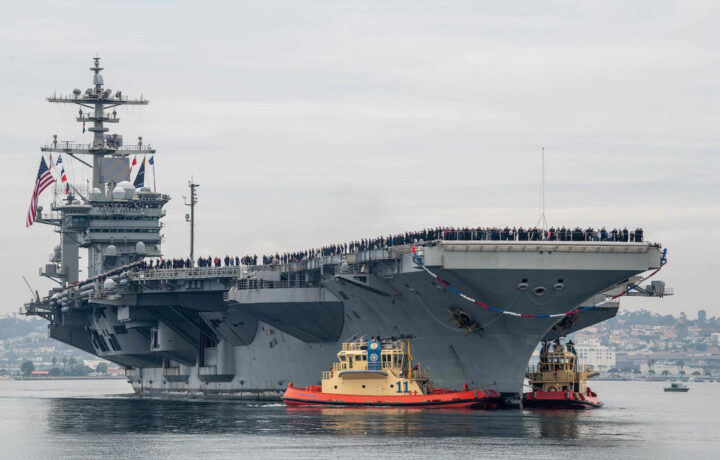The United States Navy provides sailors an opportunity to travel the world – but it often means being away from loved ones for months at a time, while some warships have seen deployments extend to nearly a year. In addition to being cut off from friends and family, sailors often have limited access to the outside world.
As the world has gotten increasingly more connected, and the vast majority of young Americans are practically tethered to their smartphones, limited network access has caused frustration and job dissatisfaction for sailors. The issue was made even worse during the COVID-19 pandemic when deployments were extended and access to the ships was limited.
In addition to impacting their free time, the limited connectivity has also impacted some in their official roles.
The sea service is now looking to make it a little easier for sailors to stay connected by taking a cue from cruise ships and cargo vessels, which have employed Starlink Internet access.
The U.S. Navy has engaged in a pilot program dubbed the Sailor Edge Afloat and Ashore (SEA2) on board the Nimitz-class nuclear-powered supercarrier USS Abraham Lincoln (CVN-72). It has provided sailors with reliable access to WiFi – and even access to a high-definition feed of the 2024 Super Bowl in real-time.
The Starlink system had also been installed and tested on the USS Gerald R. Ford (CVN-78), the lead vessel of the U.S. Navy’s newest class of nuclear-powered supercarriers.
SEA2 is the result of a collaborative effort of Naval Information Warfare Systems Command (NAVWAR); Commander, Naval Air Force, U.S. Pacific Fleet (COMNAVAIRPAC); Program Executive Office for Digital and Enterprise Services (PEO Digital); and Program Executive Office Command, Control, Communications, Computers and Intelligence (PEO C4I). It aims to improve sailors’ digital lives by providing enhanced connectivity for both work and play – while it promises to be secure.
That latter point is noteworthy as it was in June that a U.S. Navy NCO was demoted after she allowed an unsecured WiFi network to be set up on the USS Manchester (LCS-14), an Independence-class littoral combat ship (LCS).
Replacing the VSAT Terminals
The new system will utilize the low-Earth orbiting satellites from SpaceX’s Starlink and the UK’s Eutelsat OneWeb to deliver faster speeds – replacing the six geostationary satellites that orbited the Earth. Those satellites, connected to VSAT terminals on the ships provided notoriously high latency and low bandwidth.
By contrast, Starlink dishes and OneWeb terminals can receive 1Gpbs Internet speeds, upwards of 20 times faster than the previous platforms. In turn, SEA2 now ensures that sailors’ lives can continue while they’re deployed, which is increasing job satisfaction for those who spend months at sea.
“You lose all access to your personal life, and that affects people – they’re concerned about how the issues in their personal lives that they just kind of left behind will be handled. With Sailor Edge Afloat and Ashore, we can maintain the continuity of our personal lives,” CVN-72’s Combat Systems Officer Commander Kevin White told the U.S. Navy’s CHIPS magazine earlier this year. “What we’ve been able to do is transition Navy life to be more like home, and we can see onboard the ship that everybody is happier.”
Sailors still need to adhere to safe usage practices, which can include only using their phones and other devices in designated locations and at designated times. SEA2 allows sailors to have more “normal” lives when they’re off duty.
Official Business But Still Meant to Help Morale
SEA2’s connectivity isn’t just for sailors to text and talk with friends and family. It will enhance the functionality of the warship as well by enabling the transfer of tactical applications – albeit at higher classification levels and encrypted accordingly.
SEA2 has also received cybersecurity certification, whereas the previous Internet solutions onboard the ships had no full authority and were only tolerated, the U.S. Navy explained.
“The fact that we’re not making use of that opportunity with modern technology to allow classified tactical applications to ride the commercial internet is where we are missing out, so we built Sailor Edge Afloat and Ashore to be able to do that in the future,” White said. “We’re close to demonstrating a couple of those applications, and I am fully confident it will be game changing.”
The platform has also found a use for business applications, including training and healthcare – where it can update medical records and aid in triaging and even treating patients in real-time.
USS Abraham Lincoln has also been testing a program dubbed Flank Speed Edge, which the U.S. Navy describes as “a cloud system capable of transferring terabytes of data from the cloud to users aboard a ship.” That has improved the way the crew manages maintenance data and orders spare parts.
But perhaps the biggest demonstration was the aforementioned streaming of the Super Bowl in real-time. The ship held a party for those off-duty crew members that included food, popcorn stands, and a “massive sound system” where the game was projected on a makeshift 300-inch screen using a white Hangar Bay door.
“We want to escape the mindset that SEA2 is only for tactical use,” White further told DVIDS this month. “Right now, it’s all about getting the best out of our sailors by keeping them connected to home in a way they’re used to and giving them the tools to do their jobs more effectively.”




